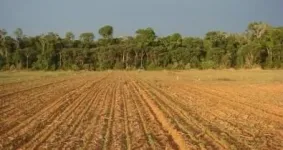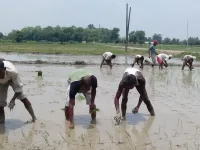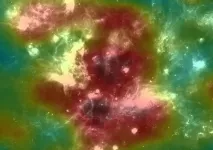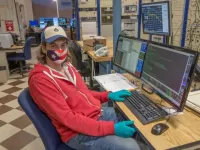(Press-News.org) Crabs are living the meme life on social media lately. The memes joke that everything will eventually look like a crab. But it's actually based in some truth.
The crab shape has evolved so many times the evolutionary biologist L.A. Borradaile coined the term carcinization in 1916 to describe the convergent evolution process in which a crustacean evolves into a crab-like form from a non-crab-like form. Crabs are decapod crustaceans of the infraorder Brachyura and are considered "true crabs", most of which are carcinized. "False crabs" are of the infraorder Anomura. This group evolved crab-like body plans three or more times from an ancestor that was not carcinized.
In a paper published on March 12 in BioEssays, a team of researchers led by Harvard University found that the crab-like body plan evolved at least five times independently in both true crabs (Brachyura) and false crabs (Anomura). They also discovered the crab-like body plan has been lost at least seven times in a process called decarcinization.
The team, led by first author Joanna M. Wolfe, Postdoctoral Researcher, Department of Organismic and Evolutionary Biology (OEB), Harvard University, examined a composite of phylogenetic data for crabs. They synthesized morphological data from key fossil and living crab groups as well as data from behavior, natural history, functional morphology, and development all from previous studies by the authors.
Construction of comprehensive datasets, including fossil and extant species, representing all crab families is crucial to identifying the key characters that define what is a crab," said Wolfe. "This will allow us to resolve the multiple origins and losses of 'crab' body forms through time and identify the timing of origin of key evolutionary novelties and body plans."
Carcinization is characterized by a wide, flat carapace (the hard upper shell) and a folded pleon (the abdomen or tail). The pleon is largely hidden under the crab body, unlike the pleon of the lobster which is visible. In decarcinization the carapace is elongated and narrow. The pleon is not bent and is usually visible or even elongated. Decarcinization is an example of a group re-evolving a morphology that had been lost, which is thought to be a rare event in evolution.
"Biologists want to know how to "predict" if a phenotype, or morphology, would evolve in a group," said senior author Heather D. Bracken-Grissom, Associate Professor, Florida International University. "Examining crab evolution provides a macroevolutionary timescale of 250 million years ago for which, with enough phylogenetic and genomic data, we might be able to predict the morphology that would result."
Wolfe agreed, "Carcinization also allows us to compare convergent evolution in fossil morphology to that in living organisms, which is not yet commonly done."
The researchers are not completely certain but posit it is likely the common ancestor of Brachyura and Anomura was not carcinized. "This evidence suggests that indeed carcinization evolved independently in those groups," said co-author Javier Luque, Postdoctoral Researcher, OEB, Harvard University and Smithsonian Tropical Research Institute.
Wolfe is currently working with Assistant Professor Javier Ortega-Hernández, OEB, Harvard University, to test the hypothesis that carcinization can be quantitatively characterized by measuring the shapes of extant crab specimens from the Museum of Comparative Zoology, Harvard University, collections.
INFORMATION:
This work was supported by the National Science Foundation DEB #1856679, DEB #1856667, and a National Sciences and Engineering Research Council of Canada (NSERC) Post- doctoral Fellowship.
Article and author details
Joanna M. Wolfe, Javier Luque, Heather D. Bracken-Grissom. 2021. How to become a crab: Phenotypic constraints on a recurring body plan. BioEssays DOI: 10.1002/bies.202100020
Corresponding author(s)
Joanna Wolfe, jowolfe@g.harvard.edu
As experts nationwide point to a mental health crisis among teens and young adults, a pilot program teaching mindfulness and coping techniques to students at the University of Washington has helped lower stress and improve emotional well-being.
New studies by the psychology researchers who created the program find that the strategies, offered first in residence halls and later through classes and other organized campus groups, have provided participants with successful methods for coping with stress, managing their emotions and learning self-compassion.
Researchers say the results show the potential for preventive mental health services offered in an accessible, peer-group environment.
"This program is not a substitute ...
In Brazil, a study conducted by researchers affiliated with the University of São Paulo (USP) and collaborators showed that deforestation in the Amazon causes an increase in the diversity of antibiotic-resistant bacteria. An article on the study, published in Soil Biology and Biochemistry, compares the microorganisms that live in the soil of native forest with those found in pasture and croplands. The researchers found a far larger number of genes considered markers of antibiotic resistance in deforested than forested areas.
“Bacteria produce substances with which to attack each other in a competition for resources that’s ...
URBANA, Ill. ¬- As the global population grows, the demand for food increases while arable land shrinks. A new University of Illinois study investigates how rice production in India can meet future needs by adapting to changing climate conditions and water availability.
"Rice is the primary crop in India, China, and other countries in Southeast Asia. Rice consumption is also growing in the U.S. and elsewhere in the world," says Prasanta Kalita, professor in the Department of Agricultural and Biological Engineering at U of I and lead author on the study.
"If you look at where they traditionally grow rice, it is countries that have ...
New research released in Bioscience found that a remote region of North America's largest temperate rainforest is experiencing changes to its ecosystem due to climate change. Brian Buma, a researcher and professor of integrated biology at University of Colorado Denver, co-leads the research network that outlined the changes in a new paper.
North America's largest remaining temperate rainforest, located in Southeast Alaska, is one of the most pristine and intact ecosystems. The entire ecosystem stretches well over 2,000 km from north to south and stores more carbon ...
New research by the National Institutes of Health found that unbalanced progesterone signals may cause some pregnant women to experience preterm labor or prolonged labor. The study in mice -- published online in the Proceedings of the National Academy of Sciences -- provides novel insights for developing treatments.
During pregnancy, the hormone progesterone helps to prevent the uterus from contracting and going into labor prematurely. This occurs through molecular signaling involving progesterone receptor types A and B, referred to as PGR-A and PGR-B. In this ...
LOS ALAMOS, N.M., March 11, 2021--A long-time question in astrophysics appears to finally be answered, thanks to a collection of large, high-tech water tanks on a mountainside in Mexico. The High-Altitude Water Cherenkov (HAWC) data shows that the highest-energy cosmic rays come not from supernovae, but from star clusters.
"The origin of the highest-energy cosmic rays in the galaxy has been an open question in astrophysics for more than 60 years," said Patrick Harding, a Los Alamos National Laboratory astrophysicist doing research using HAWC. "Very few regions of the galaxy have both the power to produce high-energy ...
Black women have 80% higher risk of preterm birth between 32 and 33 weeks of pregnancy if a Black person who lives in their neighborhood is killed by police during the pregnancy, according to a study by researchers at UC San Francisco and UC Berkeley.
The study by scientists at the UCSF California Preterm Birth Initiative (PTBI-CA) and UC Berkeley School of Public Health, studied the records of 3.8 million pregnant women to assess whether fatal police violence occurring in their neighborhood during pregnancy was associated with extremely early, early, moderate or late preterm delivery.
"Our findings suggest that deaths due to police violence, which already differentially affect Black and Brown communities, adversely affect the health of mothers and babies ...
BOSTON - As COVID-19 infection rates continue to fall, Massachusetts officials are signaling it's almost time to end remote learning and send all school-aged children back to the classroom. While emerging data suggest young children and schools have not been primary drivers of the COVID-19 pandemic, evidence to guide best practices to prevent the spread of the virus in the school setting has been limited and, as a result, national and international recommendations are inconsistent.
A study led by Beth Israel Deaconess Medical Center (BIDMC) physician-researchers provides new, much-needed data about the optimal physical ...
Climate change is affecting the water balance of our planet: depending on the region and the time of year, this can influence the amount of water in rivers potentially resulting in more flooding or drought. River flow is an important indicator of water resources available to humans and the environment. The amount of available water also depends on further factors, such as direct interventions in the water cycle or land use change: if, for example, water is diverted for irrigation or regulated via reservoirs, or forests are cleared and monocultures grown in their place, this can have an impact on river flow.
However, how river flow ...
Using the same principles that make polarized sunglasses possible, a team of researchers at the Arecibo Observatory in Puerto Rico have developed a technique that will help better defend against asteroids on a collision course with Earth.
A new study recently published in The Planetary Science Journal found a better way to interpret radar signals bounced off asteroids' surfaces. The data can better tell us if an asteroid is porous, fluffy or rocky, which matters because there are hundreds of near-Earth asteroids that could potentially hit the planet.
"Learning more about the physical properties of asteroids is crucial in Planetary Defense," says Dylan Hickson the lead author and a research scientist at the Arecibo Observatory in Puerto Rico. "A porous, fluffy asteroid does ...




